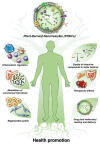The Potentiality of Plant-Derived Nanovesicles in Human Health-A Comparison with Human Exosomes and Artificial Nanoparticles
- PMID: 35563310
- PMCID: PMC9101147
- DOI: 10.3390/ijms23094919
The Potentiality of Plant-Derived Nanovesicles in Human Health-A Comparison with Human Exosomes and Artificial Nanoparticles
Abstract
Research in science and medicine is witnessing a massive increases in literature concerning extracellular vesicles (EVs). From a morphological point of view, EVs include extracellular vesicles of a micro and nano sizes. However, this simplistic classification does not consider both the source of EVs, including the cells and the species from which Evs are obtained, and the microenvironmental condition during EV production. These two factors are of crucial importance for the potential use of Evs as therapeutic agents. In fact, the choice of the most suitable Evs for drug delivery remains an open debate, inasmuch as the use of Evs of human origin may have at least two major problems: (i) autologous Evs from a patient may deliver dangerous molecules; and (ii) the production of EVs is also limited to cell factory conditions for large-scale industrial use. Recent literature, while limited to only a few papers, when compared to the papers on the use of human EVs, suggests that plant-derived nanovesicles (PDNV) may represent a valuable tool for extensive use in health care.
Keywords: drug delivery; extracellular vesicles; health; nanovesicles; organic agriculture; plants; therapy.
Conflict of interest statement
The authors declare no conflict of interest.
Figures
Similar articles
-
Novel Protocols for Scalable Production of High Quality Purified Small Extracellular Vesicles from Bovine Milk.Nanotheranostics. 2021 Jul 5;5(4):488-498. doi: 10.7150/ntno.62213. eCollection 2021. Nanotheranostics. 2021. PMID: 34367882 Free PMC article.
-
Plant Extracellular Vesicles and Nanovesicles: Focus on Secondary Metabolites, Proteins and Lipids with Perspectives on Their Potential and Sources.Int J Mol Sci. 2021 Apr 2;22(7):3719. doi: 10.3390/ijms22073719. Int J Mol Sci. 2021. PMID: 33918442 Free PMC article.
-
On the Choice of the Extracellular Vesicles for Therapeutic Purposes.Int J Mol Sci. 2019 Jan 9;20(2):236. doi: 10.3390/ijms20020236. Int J Mol Sci. 2019. PMID: 30634425 Free PMC article. Review.
-
Purposing plant-derived exosomes-like nanovesicles for drug delivery: patents and literature review.Expert Opin Ther Pat. 2023 Feb;33(2):89-100. doi: 10.1080/13543776.2023.2195093. Epub 2023 Mar 27. Expert Opin Ther Pat. 2023. PMID: 36947052 Review.
-
Extracellular vesicles: Novel promising delivery systems for therapy of brain diseases.J Control Release. 2017 Sep 28;262:247-258. doi: 10.1016/j.jconrel.2017.07.001. Epub 2017 Jul 4. J Control Release. 2017. PMID: 28687495 Review.
Cited by
-
Advances in Plant-Derived Extracellular Vesicle Extraction Methods and Pharmacological Effects.Biology (Basel). 2025 Apr 6;14(4):377. doi: 10.3390/biology14040377. Biology (Basel). 2025. PMID: 40282242 Free PMC article. Review.
-
Ex Vivo Anti-Leukemic Effect of Exosome-like Grapefruit-Derived Nanovesicles from Organic Farming-The Potential Role of Ascorbic Acid.Int J Mol Sci. 2023 Oct 27;24(21):15663. doi: 10.3390/ijms242115663. Int J Mol Sci. 2023. PMID: 37958646 Free PMC article.
-
Therapeutic application and potential mechanism of plant-derived extracellular vesicles in inflammatory bowel disease.J Adv Res. 2025 Feb;68:63-74. doi: 10.1016/j.jare.2024.01.035. Epub 2024 Feb 9. J Adv Res. 2025. PMID: 38341033 Free PMC article. Review.
-
Exosomes isolated from citrus lemon: a promising candidate for the treatment of Alzheimer's disease.Ther Deliv. 2024;15(7):507-519. doi: 10.1080/20415990.2024.2354119. Epub 2024 Jun 10. Ther Deliv. 2024. PMID: 38888652 Free PMC article.
-
Scientific Discoveries Supporting Theories in Science: From Thinking to Practice.Int J Mol Sci. 2022 Nov 30;23(23):15025. doi: 10.3390/ijms232315025. Int J Mol Sci. 2022. PMID: 36499354 Free PMC article.
References
-
- Yáñez-Mó M., Siljander P.R.-M., Andreu Z., Zavec A.B., Borràs F.E., Buzas E.I., Buzas K., Casal E., Cappello F., Carvalho J., et al. Biological properties of extracellular vesicles and their physiological functions. J. Extracell. Vesicles. 2015;4:27066. doi: 10.3402/jev.v4.27066. - DOI - PMC - PubMed
-
- Fais S., O’Driscoll L., Borras F.E., Buzas E., Camussi G., Cappello F., Carvalho J., Cordeiro da Silva A., Del Portillo H., El Andaloussi S., et al. Evidence-Based Clinical Use of Nanoscale Extracellular Vesicles in Nanomedicine. ACS Nano. 2016;10:3886–3899. doi: 10.1021/acsnano.5b08015. - DOI - PubMed
-
- Lener T., Gimona M., Aigner L., Börger V., Buzas E., Camussi G., Chaput N., Chatterjee D., Court F.A., Del Portillo H.A., et al. Applying extracellular vesicles based therapeutics in clinical trials—An ISEV position paper. J. Extracell. Vesicles. 2015;4:30087. doi: 10.3402/jev.v4.30087. - DOI - PMC - PubMed
Publication types
MeSH terms
Substances
LinkOut - more resources
Full Text Sources
Other Literature Sources


